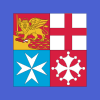User:Nc123456
Template:Good article is only for Wikipedia:Good articles.
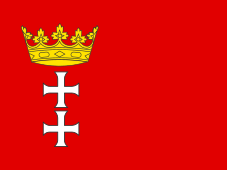 | |
| Use | City flag |
|---|---|
| Proportion | 5:8 |
| Adopted | 1 August 1996 |
| Design | A golden crown and two white crosses aligned vertically, on the hoist side of a solid red field. |
 | |
| Use | Another used drawing variant |
| Proportion | 5:8 |
| Adopted | unofficial |
 | |
| Use | Flag with full Coat of Arms |
| Proportion | 5:8 |
| Adopted | unofficial |
The flag of Gdańsk features a golden five-point crown and two square white crosses, all arranged vertically on the hoist side of the flag. It uses a 5:8 proportion. The flag, in various forms, has represented the Polish city of Gdańsk (also referred to by the name "Danzig") since the 13th century. It was formally adopted by the Gdańsk City Council in its current form for the first time on 1 August 1996.
The two crosses appeared in multiple variations in nearly all flags that have been used to represent the city, and the royal five-pointed crown was added after King Casimir IV granted the privilege of using it in May 1457. The crown and crosses have traditionally been positioned one-third of the way across the length of the flag, from the hoist side, in order to make them more visible when the flag was waving.
After the flag was not used during and after World War II, the practice was briefly departed from when the City Council approved an official flag in December 1991 which had the design elements in the center. This was changed back by another resolution in August 1996, and affirmed in 2001 with another statute after the first had expired.
History
[edit]The idea of a flag for Gdańsk can be traced to the 13th century, as some ships flew banners that were similar in design to some elements representing the city, though the low quality of the drawings and reproductions make precise identification difficult.[1] The two crosses present on the flag likely originate from a gonfanon flown on the stern of some of these ships.[2] The crosses were originally arranged side-by-side, on a red swallowtail banner, though by the second half of the 13th century the layout was changed to a rectangular flag in a vertical orientation with one cross above the other,[3] similar to that of Elbląg, another port city, whose flag was identical save for the top half, which was white with a red cross.[3] This rectangular flag was used by troops fighting in the Battle of Grunwald,[1] which took place in 1410, as is noted in the work of the historian Jan Długosz.[1] It was also used by ships of the time, including the Peter von Danzig, a large carrack in the fleet of the Hanseatic League.[4][5]
The flag's history is similar to that of the city's coat of arms, as its escutcheon is identical in design to the flag.[6] After the privilege was granted by Casimir IV, King of Poland, on 25 May 1457, the city added a golden crown to its arms,[6] which was also reflected in the city's flags.[1] The flag itself has changed shape over time as well, keeping the rectangle but changing from a vertically-oriented one to a more traditional horizontally-oriented one.[1] From the time the flag was expanded horizontally, the crown and crosses have been positioned closer to the hoist of the flag than to the fly; this was done intentionally so that they would be more visible when the flag was blowing in the wind.[1]
The specific design of the elements of the flag has varied mildly with each depiction; a near-identical design was used by the Free City of Danzig established during the Napoleonic Wars in 1807.[1] This city-state also had a trade flag, which consisted of a red field with a white stripe on the leftmost site of the flag, and the city's coat of arms in the upper-left corner.[1] It also had a customs flag, which was a red field with the coat of arms surrounded by leaves. The similarly-named Free City of Danzig, this one established in 1920, used another near-identical design for its flag.[1]
While under the control of Nazi Germany during World War II, the use of the city flag in Gdańsk was discontinued.[1] After the war, the Polish People's Republic did not restore use of the flag.[1] The city flag was officially adopted by the Gdańsk City Council on 10 December 1991, with the crown and crosses arranged vertically in the center of a red field.[1] This flag proved rather unpopular, however, and was rarely flown apart from on some occasions by municipal authorities.[1] The current flag took effect for the first time on 1 August 1996, with a City Council resolution that moved the emblems back to their traditional place on the hoist side of the flag.[1] This resolution later expired but was renewed by another statute in 2001, with the flag design unchanged.[7]
-
Hanseatic flag (c. 13th–15th centuries)
-
Flag of the Free City of Danzig (1807–1814)
-
Flag of the Free City of Danzig (1920–1939)
-
Flag of Gdańsk (1991–1996)
Other historical flags
[edit]-
Banner of the Commandery of Danzig, flown during the battle of Grunwald in 1410
-
Flag signed as belonging to Gdańsk appearing in 18th century publications.
-
Republic of Danzig flag proposal (1807)
-
State Ensign of the Free City of Danzig Dienstflagge (1920–1939)
-
Flag of the Senate of the Free City of Danzig Senatsflagge (1920–1939)
-
Postal flag and Ensign of the Free City of Danzig Postflagge (1920–1939)
-
Pilot flag of the Free City of Danzig Lotsenflagge (1920–1939)
-
Harbour Authorities' flag in Free City of Danzig (1920–1939)
-
Customs' pennant of the Free City of Danzig Zollstander (1920–1939)
-
Police Pennant of the Free City of Danzig (1920–1939)
-
Flag of police in Free City of Danzig Danziger Polizei (c. 1937–1939)
-
Flag of the SS Heimwehr Danzig (1939–1940)
-
House flag of the Gdansk Shipyard, notably used during the 1980 strikes, and flown during the signing of the Gdańsk Agreement.[8]
Other flags associated with the second Free City of Danzig used the flag in their own designs; the flag of the postal service was identical to the city flag save for a post horn added in the lower-right corner.[9][10] The police and customs pennants were similar; the former was a green pennant banner with the crown and crosses on a red background, all within a small yellow circle on the hoist side of the flag,[11] while the latter was also a pennant, with a green border, red interior, and the emblems on the hoist side.[12][13] The pilot jack was identical to the city flag, but for a thick white border, similar to that of the Pilot Jack variation of the Union Jack.[12][14] The Senate also had its own standard, this flag could be used by all members of the Senate to mark their vehicles when traveling in them for official purposes.
Design and symbolism
[edit]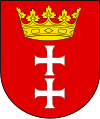
The current flag consists of a red field, with a gold five-pointed crown above two white crosses, arranged vertically. The emblems are identical to those found in the city's coat of arms, and are positioned closer to the hoist side of the flag, with the vertical axis in the center of the emblems positioned exactly one-third of the length of the flag away from the hoist edge of the flag.[6] The flag uses a 5:8 proportion.[6] Unlike in some other versions of the device, the upper cross does not enter the crown, but rather is positioned below it; this is also reflected on the city's arms.[6] The royal crown represents the permission given by King Casimir IV, while the crosses can represent both the Hanseatic League and Christianity.[6] The red color of the flag's field was a popular Hanseatic color, and also represents the right to use red wax that was given to authorities in Gdańsk by the King.[6]
See also
[edit]References
[edit]Citations
[edit]- ^ a b c d e f g h i j k l m n "Flagi Gdańska". Wydział Symbolologii (in Polish). 26 May 2005. Archived from the original on 4 May 2013. Retrieved 10 July 2022.
- ^ "Gdańsk city (Poland)". Flags of the World. 20 February 2000. Archived from the original on 7 November 2021. Retrieved 10 July 2022.
- ^ a b Znamierowski 2013, p. 13.
- ^ Możejko 2019, p. 2.
- ^ Możejko 2019, p. 121.
- ^ a b c d e f g "Opis i zasady używania herbu, flagi i pieczęci Miasta Gdańska". Gdańsk City Hall (in Polish). 18 March 2009. Archived from the original on 23 May 2010. Retrieved 10 July 2022.
- ^ Resolution No. XL / 1226/2001. Gdańsk City Council. 25 October 2001.
- ^ John Ross: Chronicle of the 20th Century. 1990. Viking Penguin Books.
- ^ Znamierowski 2013, p. 74.
- ^ "Danzig Postal Flag and Ensign 1920–1939". Flags of the World. Archived from the original on 9 August 2021. Retrieved 14 July 2022.
- ^ "Danzig Police Pennant 1920–1939". Flags of the World. Archived from the original on 3 November 2021. Retrieved 14 July 2022.
- ^ a b Znamierowski 2013, p. 22.
- ^ "Danzig Customs Pennant 1920–1939". Flags of the World. Archived from the original on 9 August 2021. Retrieved 14 July 2022.
- ^ "Danzig Pilot Flag 1920–1939". Flags of the World. Archived from the original on 4 November 2021. Retrieved 14 July 2022.
General and cited references
[edit]- Możejko, Beata (2019). Peter von Danzig: The Story of a Great Caravel, 1462–1475. Translated by Gostyńska, Barbara. Leiden: Brill Publishers. doi:10.1163/9789004408449. ISBN 978-90-04-35810-2. OCLC 1176276101. S2CID 203223349.
- Znamierowski, Alfred (2013). The World Encyclopedia of Flags. Wigston, Leicestershire, UK: Lorenz Books. ISBN 978-0-7548-2629-3. OCLC 968131022.
This article includes a list of general references, but it lacks sufficient corresponding inline citations. (December 2023) |
The flag of the Hispanic People (Spanish: Bandera de la Hispanidad, flag of the Hispanicity) is an ethnic flag used to represent the Hispanic people or Hispanic community.
Symbolism
[edit]The Flag of the Hispanicity displays a white background with three purple crosses and a rising sun.
- The white field or background symbolizes peace and purity.
- The golden Sun of May evokes the indigenous god Inti and symbolizes the awakening of the new lands.
- The three crosses pattée symbolize Christopher Columbus's three ships, the Niña, the Pinta, and the Santa María.
- The Purpure color of the crosses represents the Spanish language and comes from the ancient use of this color in the lion of the Kingdom of León's flag, which was later incorporated with the Crown of Castile.[1]
History
[edit]The flag was designed by Ángel Camblor, a captain of the Uruguayan Army. He was the winner of a contest organized by Juana de Ibarbourou in 1932. The flag was first raised in Montevideo, at the Independence Square, on 12 October 1932.
The flag was formerly known as "Flag of the Hispanic race" (Spanish: Bandera de la raza hispánica).
Alternative use as the Flag of the Americas
[edit]
The flag is also sometimes occasionally alternately used to represent the entire geographical area of The Americas and not just as an flag of the Hispanic American people.[2][3] The flag was officially adopted as the Flag of the Americas—in this usage representing, besides Hispanic Americans, also Anglo-Americans, Franco-Americans (the Québécois, Haitians, Guadeloupians, Martininqians, and French Guianians), Luso-Americans, Dutch Americans (the inhabitants of the Dutch Antilles and Suriname), and Greenlanders—by all member countries of the Pan-American Conference at their Seventh Assembly in 1933.[4]
See also
[edit]References
[edit]- ^ Cervera, César (21 July 2020). "La bandera olvidada que representa a toda la Hispanidad" [The forgotten flag that represents all of the Hispanicity]. ABC (in Spanish). ISSN 1695-2936. Archived from the original on 12 October 2021. Retrieved 10 April 2022.
- ^ Grosvenor, Gilbert; Showalter, William J. (September 1934). "Flags of the World". The National Geographic Magazine. Vol. 66, no. 3. pp. 361, 364, 367. ISSN 0027-9358. OCLC 643483454. Retrieved 10 April 2022 – via Internet Archive.
This flag, with its three wine-colored crosses and its sun of the Incas, was hoisted on October 12, 1932 in the Plaza Independencia in Montevideo. It was officially recognized and dedicated by supreme decree by the governments of Honduras, Paraguay, Chile, Bolivia, Ecuador, Columbia and Peru. All of the nations of the Americas hoisted it shortly thereafter.
- ^ Harden, Zachary, ed. (27 August 2021). "Flag of the Race". Flags of the World. Archived from the original on 14 October 2021. Retrieved 10 April 2022.
- ^ "Bandera de las Américas (Séptima Conferencia Internacional Americana, Montevideo – 1933)" [Flag of the Americas (Seventh International American Conference, Montevideo – 1933)]. Derecho Internacional (in Spanish). 29 January 2013. Archived from the original on 13 July 2021. Retrieved 10 April 2022.
| History of Italy |
|---|
 |
|
|

This is a list of flags used in Italy. For more information about the national flag, visit the article Flag of Italy.
National flags
[edit]| Flag | Date | Use | Description |
|---|---|---|---|

|
1 January 1948 | National flag | A tricolour featuring three equally sized vertical pales of green, white and red, national colours of Italy, with the green at the hoist side (proportions 3:2). |

|
9 November 1947 | Civil ensign | The flag of Italy with a shield divided into four squares representing the four Maritime Republics: Venice (represented by the Lion of Saint Mark, top left), Genoa (top right), Amalfi (bottom left), and Pisa (represented by their respective crosses). The ensign is similar to the one used by the Italian Navy, with the exception that the lion is not holding a sword, the emblem is not crowned, and the book of the Gospel is open. |

|
24 October 2003 | State ensign | The flag of Italy with the State Emblem. |
Military flags
[edit]| Flag | Date | Use | Description |
|---|---|---|---|

|
9 November 1947 | Naval ensign | The flag of Italy with a naval crown and a shield divided into four squares representing the four Maritime Republics: Venice (represented by the lion, top left), Genoa (top right), Amalfi (bottom left), and Pisa (represented by their respective crosses). |
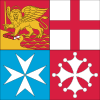
|
9 November 1947 | Naval jack | A shield divided into four squares representing the four Maritime Republics: Venice (represented by the lion, top left), Genoa (top right), Amalfi (bottom left), and Pisa (represented by their respective crosses). |

|
? | State Police's Flag | A golden eagle with shield bearing the emblem of the Italian Republic and a turreted crown on a crimson background. |
Army rank flags
[edit]Naval rank flags
[edit]Standards
[edit]| Flag | Date | Use | Description |
|---|---|---|---|

|
22 September 1965 – 21 March 1990 | Standard of the president of Italy | A square blue flag with the Emblem of Italy in the middle. |

|
22 March 1990 – 28 June 1992 | Standard of the president of Italy | A square blue flag with the flag of Italy in the middle. |

|
29 June 1992 – 13 October 2000 | Standard of the president of Italy | A square blue flag with the Emblem of Italy in the middle. |
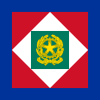
|
14 October 2000–16 January 2003 | Standard of the president of Italy | A square blue flag, with in the middle the flag of the Napoleonic Italian Republic, with the golden Emblem of Italy on the green square. |
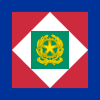
|
17 January 2003–13 April 2006 | Standard of the president of Italy | A square blue flag, with in the middle the flag of the Napoleonic Italian Republic, with the golden Emblem of Italy on the green square. |

|
14 April 2006 | Standard of the president of Italy | A square blue flag, with in the middle the flag of the Napoleonic Italian Republic, with the golden Emblem of Italy on the green square. |

|
16 May 1986 | Standard of a substitute president of Italy | A square white flag with blue border, with the Emblem of Italy in the middle. |

|
-
|
Standard of the Presidents of the Senate and the Chamber of Deputies | A rectangular white flag with light blue border, with the Emblem of Italy in the middle. |

|
17 July 2008 | Standard of the prime minister of Italy | A rectangular blue flag with two golden lines and with the Emblem of Italy (in natural colours) in the middle. |

|
23 April 2002 | Standard of the Ministry of Defence | A rectangular blue flag with two golden lines and with a star and the symbols of four Italian Armed Forces in the middle. |

|
-
|
Standard of the Civil Authorities | A rectangular white flag with two blue lines and with the Emblem of Italy (in natural colours) in the middle. |
Historical flags
[edit]Roman Empire Vexilloids
[edit]| Flag | Date | Use | Description |
|---|---|---|---|

|
27 BC-380 AD | Vexilloid of The Roman Empire. | The slogan SPQR (senātus populusque Rōmānus), "The Roman Senate and People," in gold on a field of crimson. |

|
380–395 | Labarum of Constantine the Great. | a crimson field with three dots which represents "medallions" which are said to have shown portraits of Constantine and his sons. |

|
395-476/480 | Vexilloid of The Western Roman Empire. | A Crimson field with the Chi Rho in gold in the center. |
Preunification era
[edit]| Flag | Date | Use | Description |
|---|---|---|---|
| 800–888 | Imperial Orilflamme of Charlemagne | A 3 pointed green field with 8 golden crosses and 6 flowers. | |

|
800–1420 | Flag of The Judicate of Arborea | A White Field with a Tree in the center. |

|
831–1091 | Flag of the Emirate of Sicily | A Simple Green Field. |

|
1000–1406 | Flag of The Republic of Pisa | A Red Field with a White Cross in the center. |

|
1115–1251 | 1st Flag of The Republic of Florence | A red field with centred white cross. |

|
1130–1194 | Banner of The Hauteville Dynasty | A Blue Field with a white and red checkered diagonal stripe. |

|
1160–1200 | 1st Flag of The Republic of Lucca | A Horizontal Bicolor of White and Red, similar to the Polish flag. |
| 1171–1277 | 1st Flag of Milan | A White Field with a Red Maltese cross in the center with 3 sestiere on the fly. | |

|
13th century | 1st Flag of The Republic of Siena | A black field with a white stripe and 3 sestiere on the fly. |

|
1200–1799 | 2nd Flag of The Republic of Lucca | A Blue Field with a Golden diagonal stripe with the word Libertas. |

|
1176–1395 | Flag of The Commune of Milan | A white field with centred red cross, the same of The Flag of England, both coming from Genoa. |

|
1251–1569 | 2nd Flag of The Republic of Florence | A White Field with a Red Fleur-de-lis lily in the center. |

|
1258–1266 | Banner of Manfred, King of Sicily | A White Swallowtail Flag with a Black Eagle in the center. |

|
1259–1323 | Flag of The Republic of Sassari | 4 quartered field. a white cross in the 1st and 4th quarter (blue) and a white tower in the 2nd and 3rd quarter (red). |

|
1266–1442 | Flag of The Kingdoms of Sicily and Naples under The Capetian House of Anjou | A Blue Field with Several Fleur-de-lis and a red label. |

|
1266–1442 | Flag of The Kingdoms of Sicily and Naples under The Capetian House of Anjou (Variant) | A Blue Field with Several Fleur-de-lis and a red label. |

|
1266–1442 | Flag of The Kingdoms of Sicily and Naples under The Capetian House of Anjou (Variant) | A Blue Field with Several Fleur-de-lis and a red label. |

|
1277–1395 | 2nd Flag of Milan | A white field with a blue snake devouring a man in the center. |
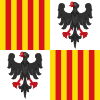
|
1282–1296 | 1st Flag of The Kingdom of Sicily under The Crown of Aragon | The Aragonese Senyera in the first and fourth quarters and the Eagle of Sicily in the second and third quarters. |

|
1290–1555 | 2nd Flag of The Republic of Siena | A Horizontal Bicolour of white and black. |

|
1296–1410 | 2nd Flag of The Kingdom of Sicily under The Crown of Aragon | Similar to the Aragonese Senyera, but with 2 white triangles with an eagle inside of both triangles. |

|
1339–1797 | Flag of The Republic of Genoa | A white field with centred red cross, similar to The Flag of England, but with five sestiere on the fly. |

|
1395–1499 | State Flag ( Vexillum publicum ) of the City of Milan | A white field with centred red cross, similar to The Flag of England. |

|
1395–1499 | 3rd Flag of Milan | the Imperial Eagle of the Holy Roman Empire in the first and fourth quarters and the Snake of Milan in the second and third quarters. |

|
1398–1701 | 1st Flag of The Principality of Piombino | A white field with a chess themed diagonal red stripe. |

|
1410–1516 | 3rd Flag of The Kingdom of Sicily under The Crown of Aragon | An inverted version of the previous flag. |

|
1416–1785 | Flag of The Duchy of Savoy | A red field with centred white cross. |

|
1442–1516 | Flag of The Kingdom of Naples under The Crown of Aragon | The Aragonese Senyera in the first and fourth quarters and the stripes of The Árpád dynasty, The Fleur-de-lis of Anjou and The Cross of Jerusalem in the second and third quarters. |

|
1443–1523 | 1st Flag of The Duchy of Urbino | A Banner of Arms with the symbols of the Holy Roman Empire, The House of Montefeltro and The Papal States. |
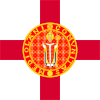
|
1447-1450 | State flag ( Vexillum publicum ) of the Golden Ambrosian Republic | A white field with centred red cross, with the republic's seal. |

|
1452–1830 | 1st Flag of The Duchy of Modena and Reggio | A crowned white eagle on a blue field. |

|
1473–1829 | Flag of The Duchy of Massa and Carrara | A White field with the coat of arms in the center. |
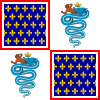
|
1499–1526 | 4th Flag of Milan (Under French rule) | the French royal flag in the first and fourth quarters and the Snake of Milan in the second and third quarters. |

|
1523–1625 | 2nd Flag of The Duchy of Urbino | A yellow swallow-tailed field with a disc which contains the symbol of The House of Montefeltro. |

|
1545–1731 | 1st Flag of The Duchy of Parma and Piacenza | A Yellow field with 6 blue Fleur-de-lis in the center. |

|
1562–1737 | 1st Flag of The Grand Duchy of Tuscany | A White Field with The Coat of Arms of The Medici Family in the center. |
| 1659–1675 | The Contarina flag of the Republic of Venice | A gold Lion of St. Mark on a field of dark red accompanied by six sestiere on the fly. | |

|
1701–1803 | 2nd Flag of The Principality of Piombino | A white field with the coat of arms in the center. |

|
1765–1800, 1815–1848 & 1849–1860 | 2nd Flag of The Grand Duchy of Tuscany | A Horizontal Tricolour of red, white and red with The Greater Coat of Arms in the center. |

|
1785–1802 | 1st Flag of The Kingdom of Sardinia | Blue with the cross of savoy occupying one quarter of the field and placed in the canton. |

|
1799–1801 | 3rd Flag of The Republic of Lucca | A Horizontal Tricolour of green, white and red. |

|
1801–1805 | 4th and Final Flag of The Republic of Lucca | A White field with a centered red diamond and with a blue border. |

|
1801–1807 | Flag of The Kingdom of Etruria | 5 Stripes alternating of Blue and White with the coat of arms in the center. |

|
1802–1814 | 2nd Flag of The Kingdom of Sardinia | Blue with the St George's Cross and four heads of Moors occupying one quarter of the field and placed in the canton. |

|
1814–1816 | 3rd Flag of The Kingdom of Sardinia | Blue with the cross of savoy and 2 St George's Crosses in the 1st and 4th quarters (one of them with four heads of Moors) occupying one quarter of the field and placed in the canton. |

|
1815–1818 | 1st Flag of The Duchy of Lucca | A Horizontal Bicolour of yellow and red. |

|
1815–1847 | 2nd Flag of The Duchy of Parma and Piacenza | A Vertical Bicolour of red and white. |

|
1815–1848 & 1849–1860 | 2nd Flag of The Grand Duchy of Tuscany (Lesser Arms Variant) | A Horizontal Tricolour of red, white and red with The Lesser Coat of Arms in the center. |

|
1816–1848 | 4th Flag of The Kingdom of Sardinia | Blue with a combination of the crosses of savoy and St George occupying one quarter of the field and placed in the canton. |

|
1816–1848 & 1849–1860 | Flag of The Kingdom of the Two Sicilies | A White Field with The Arms of The King of the Two Sicilies in the center. |

|
1818–1824 | 2nd Flag of The Duchy of Lucca | A White Field with the coat of arms in the center and a bicolour of yellow and red in the canton. |

|
1824–1847 | 3rd and Final Flag of The Duchy of Lucca | Similar to the previous flag. |

|
1830–1859 | 2nd Flag of The Duchy of Modena and Reggio | A horizontal tricolour of red, white and red with a centred vertical tricolour of blue, white and blue with the coat of arms in the center. |

|
1830–1859 | 2nd Flag of The Duchy of Modena and Reggio (Civil variant) | A horizontal tricolour of red, white and red with a centred vertical tricolour of blue, white and blue. |

|
1848–1849 | 3rd Flag of The Duchy of Parma and Piacenza | A Horizontal Bicolour of yellow and blue. |

|
1849 | Revolutionary flag of Brescia | A Square Tricolour of green,white and red |

|
1850–1851 | 4th Flag of The Duchy of Parma and Piacenza | 12 Spinning Stripes alternating of blue and yellow. |

|
1851–1859 | 5th and Final Flag of The Duchy of Parma and Piacenza | 8 Spinning Stripes alternating of blue and yellow with a red border. |
Napoleonic era
[edit]| Flag | Date | Use | Description |
|---|---|---|---|

|
1797 | Flag of the Cispadane Republic | A tricolour flag in horizontal bands with the top red, the white in the centre and the green at the bottom. In the centre was also the emblem of the republic, while on the sides the letters "R" and "C" were shown, the initials of the two words that form the name of the "Repubblica Cispadana". The coat of arms of the Cispadan Republic contained a quiver with four arrows that symbolized the four cities of the Cispadan congress. |

|
1798–1802 | Flag of the Transpadane Republic | A tricolour featuring three equally sized vertical pales of green, white and red, national colours of Italy, with the green at the hoist side. |
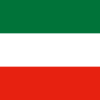
|
1797–1798 | 1st Flag of the Cisalpine Republic | A tricolour flag in horizontal bands with the top green, the white in the centre and the red at the bottom. |

|
1798–1802 | 2nd Flag of the Cisalpine Republic | A square tricolour featuring three equally sized vertical pales of green, white and red, national colours of Italy, with the green at the hoist side. |
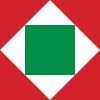
|
1802–1805 | Flag of the Italian Republic | A composition formed by a green square inserted in a white diamond, in turn included in a red box. |
| 1802–1805 | Naval Flag of the Italian Republic | A composition formed by a green square inserted in a white diamond, in turn included in a red box. | |

|
1805–1814 | Flag of The Kingdom of Italy | A composition formed by a green rectangle inserted in a white diamond, in turn included in a red box, with an imperial eagle in the center. |

|
1805–1814 | Flag of The Principality of Lucca and Piombino | A Horizontal Tricolour of Blue, White and Red |

|
1806–1808 | 1st Flag of The Napoleonic Kingdom of Naples | A Horizontal Tricolour of White, Red and Black |

|
1808–1811 | 2nd Flag of The Napoleonic Kingdom of Naples | A composition formed by a white diamond, in turn included in a red and black box, with the coat of arms in the center. |

|
1811–1815 | 3rd Flag of The Napoleonic Kingdom of Naples | A Blue field with a chess themed border of red and white and the coat of arms off-centred toward the hoist. |

|
1811-1815 | 3rd Flag of The Napoleonic Kingdom of Naples (Civil variant) | A Blue field with a chess themed border of red and white. |
Unification and Kingdom of Italy
[edit]| Flag | Date | Use | Description |
|---|---|---|---|

|
1831 | Flag of the Italian United Provinces | A tricolour featuring three equally sized vertical pales of green, white and red, national colours of Italy, with the green at the hoist side. |

|
1831 | Flag of the Young Italy | A tricolour flag in horizontal bands with the top red, white in the centre and green at the bottom, with the inscription "UNIONE, FORZA E LIBERTA'!!" |

|
1848 | Flag of the Grand Duchy of Tuscany during the First Italian Independence War | The flag bears the coat of arms of the Habsburg-Lorraine family, decorated with Italian tricolours; note, however, that the coat of arms bears the red-white-red flag of Austria, the opponent of Italian unification. |

|
1848/1849 | Flag of the Kingdom of the Two Sicilies | A white flag with Two Sicilies coat of arms, with red and green border. |

|
1848–1849 | Flag of the Kingdom of Sicily | An Italian tricolour with a trinacria in the center. |

|
1848–1849 | Flag of the Republic of San Marco | An Italian tricolour with a white canton bearing the Lion of Saint Mark. |

|
1848–1849 | Flag of the Free Cities of Menton and Roquebrune | An Italian tricolour with two hands clasping and with the inscription "Menton et Roquebrun ville libre". |

|
1848–1849 | Flag of the Grand Duchy of Tuscany | An Italian tricolour with the tuscan arms |

|
1848–1947 | Civil flag of the Kingdom of Sardinia from 1848 to 1861 and from 1861 of the Kingdom of Italy) | An Italian tricolour with House of Savoy shield in the middle. |

|
1849 | War flag of the Roman Republic The state flag had no letters. |
An Italian tricolour with two "R"s (Repubblica Romana) in the center. |

|
1859–1860 | Flag of the United Provinces of Central Italy | An Italian tricolour. |

|
1860–1861 | Flag of the Kingdom of the Two Sicilies | An Italian tricolour with the arms of the King of the Two Sicilies in the center. |

|
1861–1946 | State flag of the Kingdom of Sardinia from 1848 to 1861 and from 1861 of the Kingdom of Italy and the Naval ensign of the Regia Marina | An Italian tricolour with Savoy shield and Royal crown in the middle. |

|
1860–1946 | War flag of the Regio Esercito | A square Italian tricolour with Savoy shield and simplified Royal crown in the middle. |
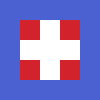
|
1879–1900 | Naval jack of the Regia Marina | A square Savoy shield with blue border. |

|
1900–1947 | Naval jack of the Regia Marina | A rectangular Savoy shield with blue border. |

|
1880–1946 | Royal Standard of the King of Italy | A blue flag with an eagle with crown and four crown at corners. |

|
1880–1946 | Royal Standard of the Prince of Piedmont | A blue flag with an eagle with crown in the middle and four crown at corners. |

|
1927–1943 | Standard of the Head of Government and Duce of Fascism | A blue flag with a yellow line and a yellow fasces in the middle. |

|
1927–1943 | Standard of a State Minister | A white flag with a blue line and a blue fasces in the middle. |

|
1927–1943 | Standard of a State Subsecretary | A white flag with a blue fasces in the middle. |

|
1927–1943 | Standard of the Minister of the Regia Marina | A blue flag with a yellow line and a yellow anchor dominated by a yellow crown in the middle. |

|
1927–1943 | Standard of the Minister of Aeronautics | A blue flag with a red line and a red eagle dominated by a red crown in the middle. |

|
1938–1941 | Standard of the Viceroy of Italian East Africa | A white flag with blue border, with the Savoy shield in the middle and four fasces at corners. |

|
1936–1945 | Flag of the Colonna Italiana | A tricolour flag with a red dagger and the red letters "G" and "L". |

|
1939–1943 | Standard of the Lieutenant General of Albania | A white flag with blue border and a red line, with fasces dominated by a crown in the middle. |

|
1943–1945 | Flag of the Italian Social Republic | An Italian tricolour. |

|
1943–1945 | War flag of the Italian Social Republic | An Italian tricolour with dark-grey eagle clutching a fasces in the center. |

|
1943–1945 | Flag of the National Liberation Committee | An Italian tricolour with a star inside which is the word "CLN". |

|
1943–1945 | Flag of the Tuscan Liberation Committee | |

|
1943–1945 | Flag of the Brigate Garibaldi | An Italian tricolour with a red star in the center. |
Italian Republic
[edit]| Flag | Date | Use | Description |
|---|---|---|---|

|
1945–1992 | Flag of the Italian ethnic minority[1] in Yugoslavia | An Italian tricolour with a red star in the center. |

|
1992– | Flag of Italians of Croatia | An Italian tricolour. |

|
1950–1960 | Flag of the Trust Territory of Somaliland | An Italian tricolour. |

|
1946–2003 | Flag of Italy | An Italian tricolour. |

|
2003–2006 | Flag of Italy | An Italian tricolour. |

|
2006– | Flag of Italy | An Italian tricolour. |

|
2006– | Flag of Italy | An Italian tricolour. |
Regional flags
[edit]Official regional flags
[edit]Ordinary regions
[edit]| Flag | Year of adoption | Use |
|---|---|---|

|
1999
(modified in 2023) |
Flag of Abruzzo |

|
2001
(modified in 2011) |
Flag of Apulia |

|
1995 | Flag of Basilicata |

|
1995 | Flag of Calabria |

|
Flag of Campania | |

|
1995 | Flag of Emilia-Romagna |

|
Flag of Lazio | |

|
1997 | Flag of Liguria |

|
1975 | Flag of Lombardy |

|
1995 | Flag of Marche |

|
Flag of Molise | |

|
1995 | Flag of Piedmont |

|
1995 | Flag of Tuscany |

|
2004 | Flag of Umbria |

|
1975
(modified in 1999) |
Flag of Veneto |
Autonomous regions
[edit]
|
2006 | Flag of Aosta Valley |

|
2001 | Flag of Friuli-Venezia Giulia |

|
1950
(modified in 1999) |
Flag of Sardinia |

|
2000 | Flag of Sicily |

|
1995 | Flag of Trentino-Alto Adige/Südtirol |
Historical regional flags
[edit]| Flag | Date | Use |
|---|---|---|

|
1999–2023 | Flag of Abruzzo |

|
1998–2002 | Flag of Apulia |

|
pre–2011 | Flag of Apulia |

|
1995 | Flag of Lazio |

|
~1980 | Flag of Molise |

|
pre–1999 | Flag of Sardinia |

|
1995 | Flag of Sardinia |

|
1995–2000 | Flag of Sicily |

|
pre–1995 | Flag of Tuscany |

|
1975–1999 | Flag of Veneto |
Flags of historical and cultural regions
[edit]
|
Flag of Friuli |

|
Flag of Montferrat |

|
Flag of Elba |

|
Flag of the Sette Comuni of Asiago Plateau |

|
Flag of Occitan Valleys |
Proposed regional flags
[edit]
|
Proposed flag for Aosta Valley by Lega Nord |

|
Proposed flag for Calabria (2024) |

|
Proposed flag for Carnia |

|
Proposed flag for Emilia (1990) by Lega Nord |
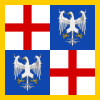
|
Proposed flag for Emilia presented in Quaderni Padani n°46 |

|
Proposed flag for Emilia (2019) |

|
Proposed flag for Romagna by Lega Nord - Romagna |

|
Proposed flag for Romagna (Variant) Lega Nord - Romagna |

|
Proposed flag for Romagna by Movement for the Autonomy of Romagna |

|
Proposed flag for Friuli by Lega Nord |

|
Proposed flag for Liguria by Lega Nord |

|
Proposed flag for Insubria |

|
Proposed flag for Lombardy (1990) |

|
Proposed flag for Lombardy (2011) |

|
Proposed flag for Lombardy (2015) |

|
Proposed flag for Lombardy (2015) |

|
Proposed flag for Lucania |

|
Proposed flag for Lunezia by Associazione Lunezia |

|
Proposed flag for Marche by Lega Nord |

|
Proposed flag for Trentino by Lega Nord |

|
Proposed flag for Umbria by Lega Nord |

|
Proposed flag for Venezia Giulia |
Provincial flags
[edit]Municipal flags
[edit]Political flags
[edit]| Flag | Date | Party | Description |
|---|---|---|---|
current
| |||
 |
2017–present | Frontal Action | |
 |
2017–present | Power to the People | |
 |
2016–present | Italian Communist Party | |
 |
2014–present | Us with Salvini | |
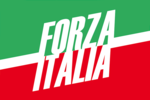 |
2013–present | Forza Italia | |
| 2009–present | Five Star Movement | ||
 |
2007–present | Democratic Party | |
| 2020–present | New Force | ||
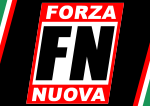 |
2006-2020 | ||
 |
1997–2000 | ||
 |
2009–present | Communist Party | |
 |
2006–present | Students' Block | |
 |
2003–present | CasaPound | |
 |
1996–present | Lega Sud Ausonia | |
| 1995–present | Tricolour Flame | ||
 |
1992–present | CARC Party | |
 |
1991–present | Communist Refoundation Party | |
| 1991–present | Lega Nord | ||
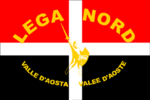 |
1991–present | Lega Vallée d'Aoste | |
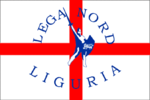 |
1991–present | Lega Liguria | |
| 1991–present | Lega Lombarda | ||
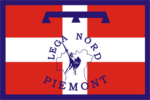 |
1991–present | Lega Piemonte | |
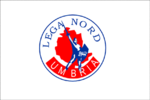 |
1991–present | Lega Umbria | |
| 1977–present | Italian Marxist–Leninist Party | ||
former
| |||
| 2002-2000 | Democracy is Freedom – The Daisy | ||
 |
1998-2014 | Party of Italian Communists | |
 |
1998-2007 | Democrats of the Left | |
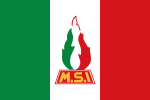 |
1946-1995 | Italian Social Movement | |
 |
1943-1994 | Christian Democracy | |
 |
1946-1951 | Movement for the Independence of Sicily | Still used in Sicilian separatism |
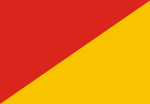 |
1943-1946 | ||
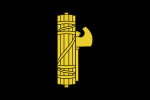 |
1923-1943 | National Fascist Party | |
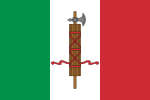 |
1919–1923 | ||
 |
1926-1991 | Italian Communist Party | |
 |
1951–1991 | ||
 |
early 19th century | Carbonari | |
other
| |||
 |
2016–present | Associazione Ricreativa e Culturale Italiana | |
| Link to file | 2007–present | Banner used in protests helmed by South Tyrolean Freedom. | |
 |
1996–present | Flag of Padanian nationalism | |
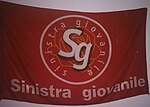 |
1990-2007 | Youth Left | |
 |
1970–1988 1990s–2000s |
Red Brigades | |
 |
1960–1976 | National Vanguard | |
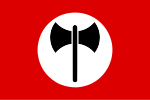 |
1956-1973 | Ordine Nuovo | |
 |
1944–present | War flag of the Italian Social Republic, currently popular fascist flag | |
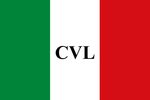 |
1943–1944 | Volunteers of Freedom Corps | |
 |
1929–1945 | Giustizia e Libertà | |
 |
1923-1943 | Voluntary Militia for National Security, paramilitary wing of the National Fascist Party. | |
 |
1921–1924 | Arditi del Popolo | |
 |
1921–1924 | Arditi del Popolo, section Civitavecchia. | |
Ethnic groups flags
[edit]| Flag | Date | Company | Description |
|---|---|---|---|
 |
1920–present | Flag of Ladins |
| Flag | Date | Company | Description |
|---|---|---|---|
current
| |||
 |
1947–present | Grimaldi Group | |
 |
1921–present | Messina Line | |
former
| |||
 |
1932-2002 | Italian Line | |
 |
1937-1988 | Sitmar Cruises | |

|
1926-1955 | Società Ricuperi Marittimi | |
Citations
[edit]- ^ Namely Istrian Italians and Dalmatian Italians
References
[edit]
 | |
| Use | Civil flag and ensign |
|---|---|
| Proportion | 2:3 |
| Adopted | 1804 |
| Relinquished | 1918 |
| Design | A horizontal bicolour of black and yellow. |

Since the days of Rudolph of Habsburg and the 1283 Treaty of Rheinfelden, the combination of red-white-red was widely considered to be the Austrian (later also Inner Austrian) colours used by the ruling Habsburg dynasty. Black and gold later became the colours used by the Imperial House of Habsburg when they held the title of Holy Roman Emperor, as they did from the mid-15th century all the way to the dissolution of the Holy Roman Empire in 1806, and were themselves derived from the banner of the empire.[1] The original form of this flag featured a gold background with a black double-headed eagle. However, this proved to be a complicated design, and was hard to reproduce. In the 18th century, a simpler form with black and gold bars started to appear in the lands ruled by the Holy Roman Emperor. With the end of the Holy Roman Empire in 1806, this flag was approved for use as a civil flag. The black–gold flag was used in a way similar to a modern national flag by the Austrian Habsburg monarchy within the Holy Roman Empire, by the later Austrian Empire, and by the Austrian part of Austria-Hungary, and was sometimes informally used for the entire empire, up until 1918.
During the reign of Emperor Joseph II, the Austrian, later Austro-Hungarian Navy started using a naval ensign (Marineflagge) based on the red–white–red colours, and augmented with a shield of similar colours. Both this and the black–gold flag became obsolete with Austria-Hungary's dissolution in 1918, and the newly-formed rump state of German Austria adopted the red–white–red triband as its national flag.
During the Bosnian Crisis, prince Nicholas I of Montenegro issued a statement on 6 October 1908 condemning the Habsburg annexation of Bosnia and Herzegovina (lands which he, along with the Kingdom of Serbia and his own Principality of Montenegro, identified as "Serbian"), rhetorically portraying the black–yellow flag as "a visible sign of injustice": "Montenegrins! Your two sad sisters, Bosnia and Herzegovina, which thirty years ago were momentarily illuminated by the rays of freedom, today were completely torn from the Serbian embrace. The Austro-Hungarian monarchy replaces the possession of those two provinces with the final annexation. (...) The marks of black and yellow colour down the Serbian land will not be a border, which will separate you in spirit and thought from your brothers. On the contrary, these features will be a visible sign of injustice; it will make the bonds even stronger and the pledge of permanent trust in the victory of Justice."[2]
The flag is similar to the flags of Namur, Belgium, of Munich, Germany, and of the German state of Baden-Württemberg.
See also
[edit]References
[edit]- ^ Volker Preuß. "National Flaggen des Österreich-Ungarn" (in German). Retrieved 3 November 2004.
- ^ "Књажевска прокламација од 6. октобра 1908. — Викизворник, слободна библиотека". sr.wikisource.org. Retrieved 20 July 2023.




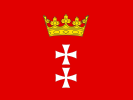






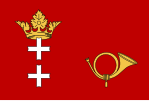

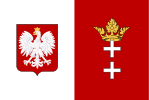




![House flag of the Gdansk Shipyard, notably used during the 1980 strikes, and flown during the signing of the Gdańsk Agreement.[8]](http://upload.wikimedia.org/wikipedia/commons/thumb/c/cd/White-blue-white_flag_3-5_version.svg/167px-White-blue-white_flag_3-5_version.svg.png)





